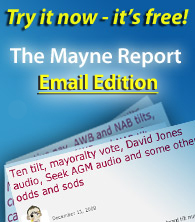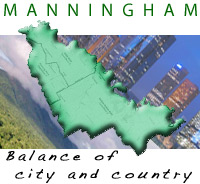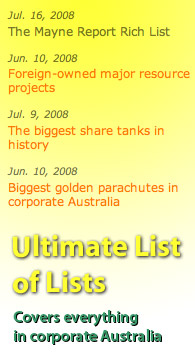ASX SFE offer, Alumina and West Papuans
July 22, 2008
There are Stephen Mayne's three stories from the Crikey edition on Monday, 27 March, 2006.
3. ASX monopolists offer $2.3bn for SFE
By Stephen Mayne
Those gouging monopolists at the ASX this morning revealed they are having another try at merging with their rivals at SFE Corp, the old Sydney Futures Exchange which demutualised in 2000, in a $2.3 billion deal that will create the world's ninth biggest listed exchange.
ASX is paying a big price to get SFE board endorsement by proposing to deliver 40% of the combined group to SFE shareholders who will receive 0.51 ASX shares for each SFE share. Based on ASX's Friday closing price of $32.60, this valued SFE shares at $16.63 - a hefty 25% premium to recent trading and more than eight times the lows of $2 reached in late 2002.
It will be interesting to see whether ASX refers trading in SFE shares to ASIC for a formal insider trading investigation because SFE shares soared from $12.75 on March 10 to Friday's close of $14.12 as news of the proposed merger leaked out.
SFE shares are up another $2.88 to a record $17 this morning after peaking at $17.60 whilst ASX shares have also soared $1.31 to $33.91, meaning today's proposal has lifted the combined market capitalisations of the wedding partners by $540 million at 11.30am to a record $5.8 billion.
The ASX has long been Australia's most lucrative government-endorsed monopoly. The 606 original stockbroking owners of the ASX, back when it was a mutual serving the investing public in a not-for-profit way, have seen their $25,000 investment turn into more than $6 million. These fat cats paid just 15c for each of their 166,000 shares in the demutualisation, meaning they have enjoyed an almost 300-fold return when dividends are included.
There aren't too many other businesses that generated EBITDA margins of 58% in 2005 but the ASX's $291 million in revenue translated into operating earnings of $169 million last year. That's what you call gouging, yet the ACCC and the Federal Government are tolerating more price increases from July next year and the competition regulator has already given preliminary approval for this merger which will hugely increase ASX market power. Has anyone considered the long-suffering consumer in all of this?
Maurice Newman, the PM's great mate who has chaired the ASX for a decade, will be chairman of the combined business into the future despite turning 68 next month, whilst ASX CEO Tony D'Aloisio will be CEO. SFE will score three ASX board seats.
Australia was a global leader in creating the hugely conflicted situation of turning a regulator into a profit-motivated listed company and ASX and SFE are proposing to merge their surveillance and supervision operations into one entity. Is this really in the public interest? How many market integrity types will be axed in the pursuit of "synergies"?
Australia is great at producing service sector giants that rely on government concessions to gouge their customers and this deal will make the ASX a leading example. Sadly, all this ASX wealth is coming from the long-suffering mum and dad investors who have their superannuation tickets clipped every which way by a government which seems to have little concern about ever-concentrating Australian corporate power.
9. Will the West Papuans come to Rio – in Melbourne?
By Stephen Mayne
The granting of three year temporary protection visas for the 42 West Papuan activists who arrived by boat earlier this year has severely strained Australia's relationship with Indonesia and also refocused attention on the giant Grasberg gold and copper mine, which is operated by controversial New Orleans-based mining company Freeport McMoran Copper and Gold.
London-based Rio Tinto sold its 13 per cent stake in Freeport for $US882 million in March 2004 but has a 40 per cent interest in Grasberg's copper and gold reserves discovered after 1994. The SMH quoted Macquarie Equities predicting the mine would produce $US155 million in revenue for Rio last year.
The Rio Tinto AGM is usually a volatile affair and the dual-listed company will be fronting its Australian shareholders at the Sofitel in Melbourne on the morning of 4 May. And guess where the West Papuan activists have decided to settle? Yep, Melbourne. The odds must be shortening that Rio will face plenty of curly questions about its continuing involvement in West Papua, including from some of the activists in question.
The Rio Tinto board is used to facing lively AGMs with environmentalists, unionists and activists lining up to have a swing at its sprawling global empire through the first, second and third worlds. However, the stars are really lining up this time as the Grasberg mine remains at the heart of the West Papuan independence fight.
As Michael Pascoe pointed out last week, BHP did the decent thing at Ok Tedi in PNG when environmental concerns boiled over and land owners sued in the Victorian Supreme Court. The same can't be said for Rio in West Papua and it is not a good look that the CEO and CFO of Freeport have just helped themselves to $116 million for their fine work in creating a one-mine company worth $US10 billion after reporting a record profit of $US995 million last year.
Compare that with the $60 million annual community development contribution which Freeport, Indonesia's biggest taxpayer, makes to the local West Papuan people. No wonder Rio snaffled former DFAT secretary Ashton Calvert for its board as it weighs up this volatile situation.
Given the complete failure of Calvert's DFAT to stop Saddam Hussein pocketing $280 million from the AWB, you'd hope a few Rio shareholders would vote against his election on 4 May.
Rio Tinto is not exactly struggling to get by with its latest $7 billion profit and market capitalisation of almost $90 billion, so it will be interesting to hear from the board about Freeport's on-going negotiations with the long-suffering people of West Papua who face an appalling environmental disaster courtesy of the Grasberg mine.
Rio will probably say that they did the decent thing in selling out of Freeport and lament that they left plenty on the table given the 13% stake is now worth $US1.3 billion. Sounds like a familiar tale to the highly pressured $500 million exit from its Indonesian coal ventures in 2003 which has proved an absolute bonanza for Aburazil Bakrie, the appropriately titled minister for social welfare in Indonesia, who has just sold his Bumi Resources empire for $US3.2 billion.
Perhaps Bakrie could redirect some of his newfound wealth to the welfare of the people of West Papua, who still resent the way Indonesia installed itself as the new colonial power in 1963 and then handed over mining rights to Freeport just a couple of weeks after a corrupt fellow called Suharto became President on March 12, 1963.
28. The lunch club continues at Alumina
By Stephen Mayne, Alumina shareholder
Alumina's annual report was released on Friday and it seems corporate Australia's cosiest and most expensive lunch club continues to prosper. For those who don't know, Alumina is what's called a postbox company. It doesn't actually do anything because its only asset is a passive 40% stake in a global aluminium and bauxite joint venture, AWAC, which is run out of Pittsburg by Alcoa of America.
Alumina chairman Don Morley admitted at the 2003 AGM that the AWAC joint venture only cost $3.5 million to run when it was part of WMC but this had blown out to $8 million after Alumina demerged with WMC in 2002.
Part of this blow-out is because an overpaid board of mining has-beens are milking the company. The old Melbourne mining network has recyled tired old directors such as Mark "Pasminco, Mayne, Homeside" Rayner and retrenched BHP veteran Ron McNeilly. They are supported by long-standing WMC lawyer and Melbourne Club type Peter Hay and chairman Don Morley, who was WMC's finance director for almost 20 years.
In its first year Alumina's non-executive directors fetched $85,000 a year whilst chairman Morley pocketed $212,500. This rose to $92,000 and $231,000 in 2004 and then the NEDs got a tasty rise to $120,000 in 2005.
The board at least held off on any pay rise for 18 months but then this appeared on page 35 of the 2004 annual report: "It was determined not to grant fee increases during 2004. A total of $509,575 was paid in non-executive director fees in 2004 before the effect of the previous WMC Stock Appreciation Plan. The board did, however, commission an independent expert review of non-executive director remuneration, and taking into account their advice approved an increase in non-executive director fees of $25,000 per annum effective 1 January 2005."
Crikey again attacked the board at last year's AGM and asked why on earth they met 20 times in 2004? Sounds like the old boys network is running a fortnightly lunch club.
This year the full board only met 13 times but the four non-executive directors sit on all the committees and it just so happened that the audit committee met nine times, the compensation committee seven times and the nomination committee three times. Why would the nomination committee meet when no fresh faces were added to board. It sounds like the boardroom lunch club is still gathering for a fortnightly catch-up paid for by the Alumina shareholders.
Sure, Alumina shares are up from $6 to $7.30 over the past year and the company is now capitalised at $8.5 billion, but that is entirely due to booming global demand and the management out of Pittsburg.
Australia's mining industry used to be run out of Melbourne but the collective incompetence of the cosy club largely squandered the dowry. Seeing some of these discredited dinosaurs in their late 60s hanging on to this Alumina rort does no-one any credit. It's time for the shareholders to act by voting down the remuneration report and giving chairman Morley a serious re-election scare at the AGM on April 27 in Melbourne.
Copyright © 2024 The Mayne Report. All rights reserved






















